Ata-ul-Haye Nasir, Ahmadiyya Archive & Research Centre
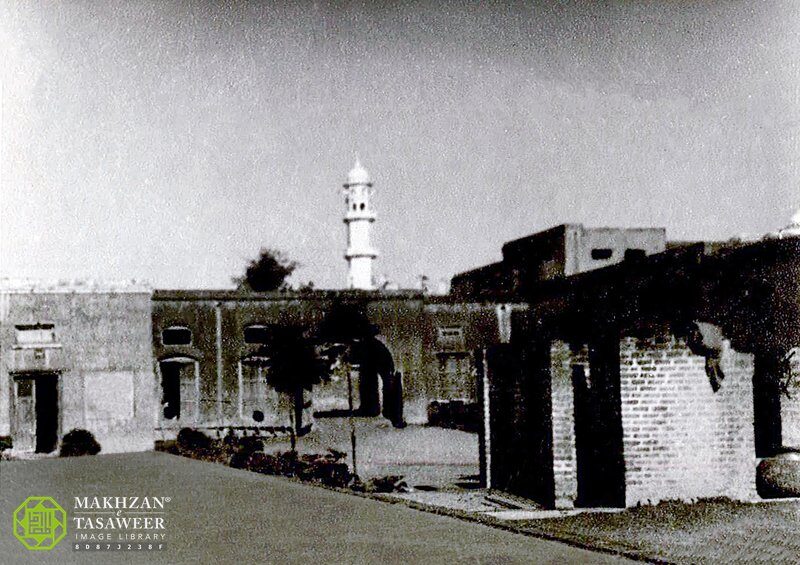
Who was Henri Lammens?
Henri Lammens was born in Ghent, Belgium, on 1 July 1862. He was a member of the “Society of Jesus” (The Jesuits) – a Roman Catholic order of religious men founded by St. Ignatius of Loyola in 1540 and approved by Pope Paul III. Henri Lammens joined the Society in Beirut, Lebanon, at the age of 15, and settled permanently there. He mastered Arabic as well as Latin and Greek, and studied philosophy at the Jesuit-run Saint Joseph University, Beirut.
He served as a lecturer in the Arabic language at the same university between 1886 and 1891. He served as the editor-in-chief of Saint Joseph University’s Arabic periodical, Al-Bashir, until 1903. In 1927, he inherited the direction of the Al-Mashreq academic journal. He passed away in 1937. (Franck Salameh [2018], “A Man for Others: The life and times of Lebanese Jesuit Henri Lammens [1862–1937]”, The Journal of the Middle East and Africa, 9:2, 213-236, DOI: 10.1080/21520844.2018.1500240)
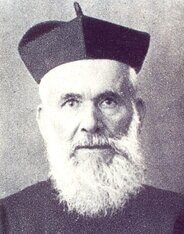
‘L‘Islam: Croyances et Institutions’
Henri Lammens wrote various books on Islam and its history, one of them being “L‘Islam: Croyances et Institutions” (1926), in which he also mentioned the Ahmadiyya Muslim Community, the claims of Hazrat Mirza Ghulam Ahmadas of Qadian, and the worldwide missionary efforts of the Jamaat. (L‘Islam: Croyances et Institutions, Imprimerie Catholique, Beirut, 1926, pp. 205-207)
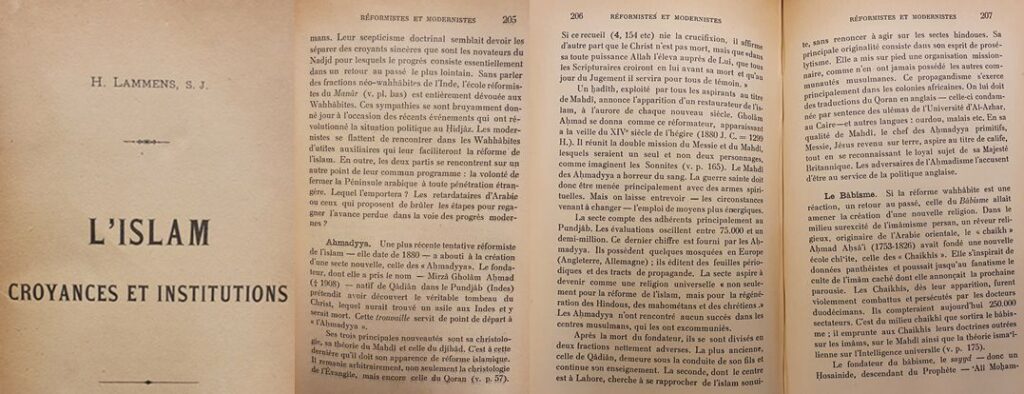
English translation of ‘L‘Islam: Croyances et Institutions’
Its English translation was rendered in 1929, titled “Islam: Beliefs and Institutions”, by Sir Edward Denison Ross (1871-1940), an orientalist and linguist, and the first Director of the School of Oriental Studies (now SOAS), London.
Sir Denison Ross also chaired the Executive Committee of the “Conference on Some Living Religions within the Empire”, held at the Imperial Institute in London, from 22 September to 3 October 1924, which was graced with the presence of Hazrat Musleh-e-Maud, Mirza Bashir-ud-Din Mahmud Ahmadra.
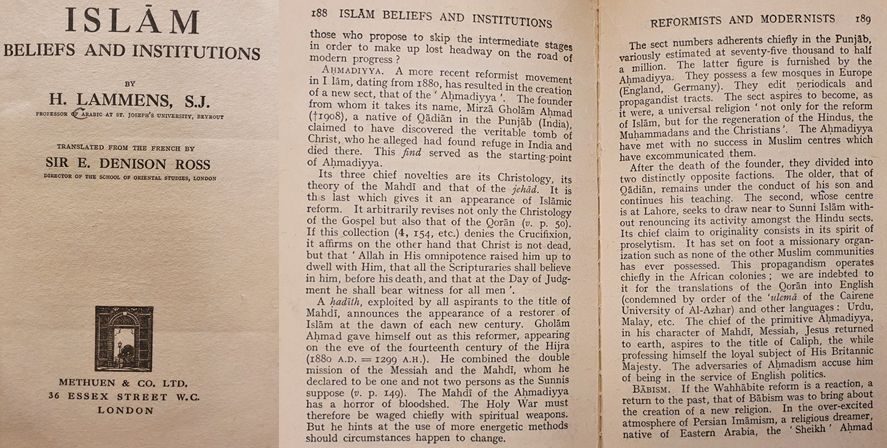
Reviews of this book
Many academics have written reviews on this book. A review by SD Goitein was published in Kirjath Sepher – a quarterly bibliography review of the Jewish National and University Library in Jerusalem – in its June-September 1928 issue. Another review by L Rigoulet was published in Mélanges de l‘Université Saint-Joseph, in its 11th volume (1926).
Introduction of Ahmadiyyat by Henri Lammens
In his book, Henri Lammens has included an introduction to various movements within Islam, and thus, he has also given a detailed introduction to Ahmadiyyat and its worldwide missionary efforts.
It is worth acknowledging that the author incorporates particular perspectives pertaining to Ahmadiyyat, which seemingly stem from his individual comprehension or convictions. Consequently, such interpretations should not be misconstrued as a comprehensive or accurate representation of the viewpoints or beliefs espoused by the Ahmadiyya Muslim Community.
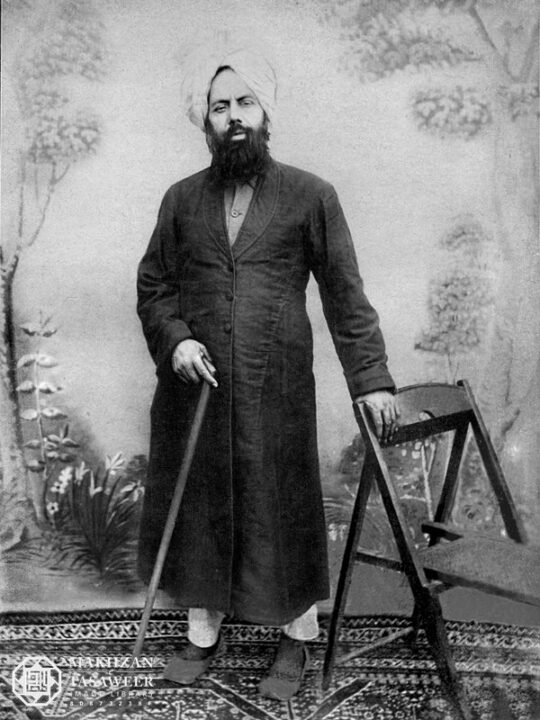
While mentioning the Ahmadiyya Muslim Community, Henri Lammens states:
“[Translation from French by Sir E Denison Ross]
“AHMADIYYA: A more recent reformist movement in Islam, dating from 1880 [the year when the first two parts of Barahin-e-Ahmadiyya were published], has resulted in the creation of a new sect, that of the ‘Ahmadiyya’. The founder from whom it takes its name, Mirza Gholam Ahmad[as] (d. 1908), a native of Qadian in the Punjab (India), claimed to have discovered the veritable tomb of [Jesusas] Christ, who,” he claimed, “had found refuge in India and died there. This find served as the starting-point of Ahmadiyya. Its three chief novelties are its Christology, its theory of the Mahdi and that of the jehad. It is this last which gives it an appearance of Islamic reform.” (Islam: Beliefs and Institutions [L‘Islam: Croyances et Institutions], Translated by Sir E Denison Ross, 1929, Methuen & Co. Ltd., London, p. 188)
He further states:
“A hadith,” utilised “by all aspirants to the title of Mahdi, announces the appearance of a restorer of Islam, at the dawn of each new century. Gholam Ahmad[as] gave himself out as this reformer, appearing on the eve of the fourteenth century of the Hijra (1880 A.D. = 1299 A.H.). He combined the double mission of the Messiah and the Mahdi, whom he declared to be one and not two persons, as the Sunnis suppose (v. p. 149). The Mahdi of the Ahmadiyya has a horror of bloodshed. The Holy War must therefore be waged chiefly with spiritual weapons.” (Ibid.)
He continues:
“The sect numbers adherents chiefly in the Punjab, variously estimated at seventy-five thousand to half a million. The latter figure is furnished by the Ahmadiyya. They possess a few mosques in Europe (England, Germany). They edit periodicals and propagandist tracts. The sect aspires to become, as it were, a universal religion ‘not only for the reform of Islam, but for the regeneration of the Hindus, Muhammadans and the Christians.’ The Ahmadiyya have met with no success in Muslim centres, which have excommunicated them.
“After the death of the Founder, they divided into two distinctly opposite factions. The older, that of the Qadian, remains under the conduct of his son [Hazrat Mirza Bashir-ud-Din Mahmud Ahmad, Khalifatul Masih IIra] and continues his teaching. The second, whose centre is at Lahore, seeks to draw near to Sunni Islam without renouncing its activity amongst the Hindu sects.” (Ibid., p. 189)
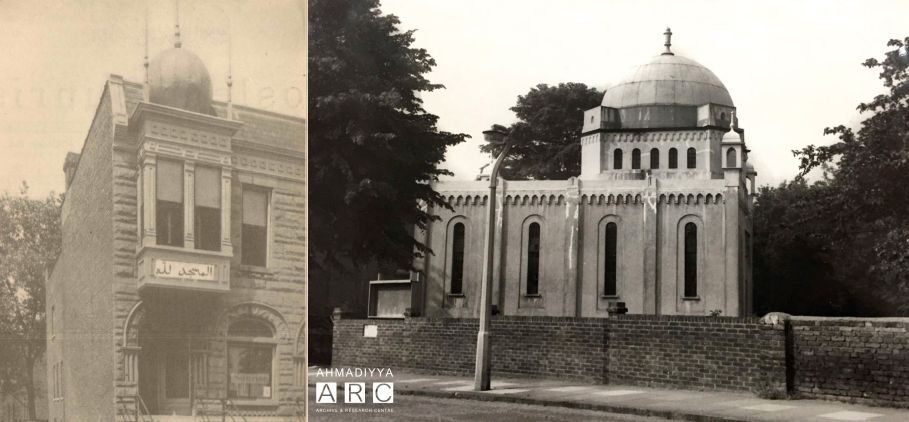
In regards to the missionary efforts of the Ahmadiyya Muslim Community, he states:
“It has set on foot a missionary organisation such as none of the other Muslim communities has ever possessed. This propagandism operates chiefly in the African colonies; we are indebted to it for the translations of the Qoran into English (condemned by order of the ‘ulema of the Cairene University of Al-Azhar) and other languages: Urdu, Malay, etc. The chief of the primitive Ahmadiyya, in his character of Mahdi, Messiah, Jesus returned to earth, aspires to the title of Caliph, while professing himself the loyal subject of His Britannic Majesty. The adversaries of Ahmadism accuse him of being in the service of English politics.” (Ibid.)
Revised edition with some further details
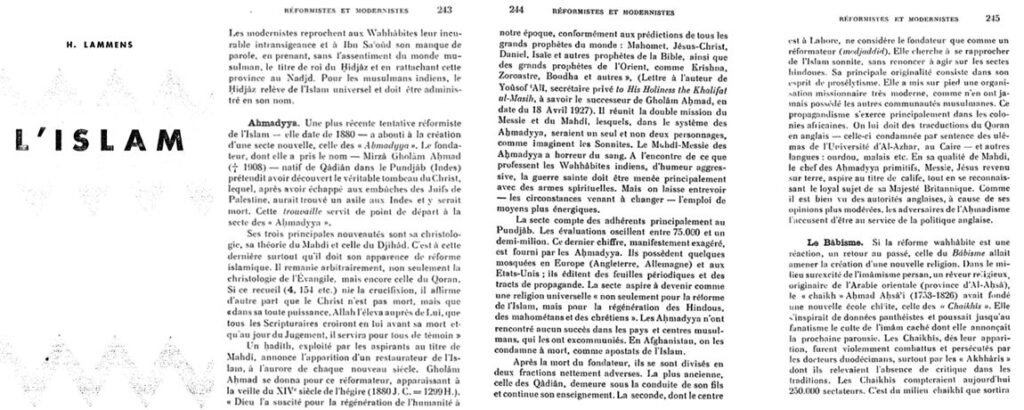
In 1943, a revised edition of this book was published from Beirut, with some further details. It also referenced a letter, dated 18 April 1927, from Sheikh Yousuf Ali Sahib, the then Private Secretary to Hazrat Khalifatul Masih IIra. The following quotation from that letter was included in the revised edition:
“God raised him [Hazrat Ahmadas] up for the regeneration of mankind in our time, in accordance with the predictions of all the great prophets of the world: Muhammad[sa], Jesus[as] Christ, Daniel[as], Isaiah[as] and other prophets of the Bible, as well as the great prophets of the East, such as Krishna[as], Zoroaster[as], Buddha[as] and others.” (L‘Islam: Croyances et Institutions, Beirut, 1943, p. 244)

